bass flute
All scores that include a part for at least one bass flute.
- 1
- 2
Bach - Adagio and Fugue from BWV 564 – arr. Flute Quartet
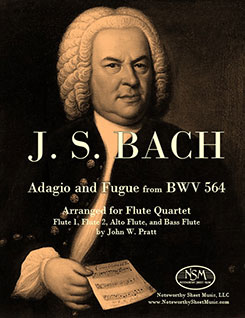 Adagio and Fugue from BWV 564, by J. S. Bach
Adagio and Fugue from BWV 564, by J. S. Bach
Arranged for Flute Quartet by John W. Pratt
Score and Parts for Flute 1, Flute 2, Alto Flute, and Bass Flute, PDF $21.25
Among J. S. Bach's big organ works, the Toccata, Adagio, and Fugue, BWV 564 is atypical in ways that make it especially adaptable to transcription for winds, as we noted when transcribing it for woodwind quartet. The middle movement Adagio has an elaborate and gorgeous melody which lies comfortably for flute and can benefit greatly from the shaded, nuanced dynamics and articulations that a solo flutist can provide. The four-part Fugue is unusual, too—light and lighthearted, happily adaptable to woodwinds. The Adagio and Fugue are particularly well-suited to a flute quartet and these (but not the Toccata) are included in John Pratt’s arrangement of the piece for two flutes, alto flute and bass flute. Note that the score is presented with the alto flute line in concert pitch and the bass flute line shown in bass clef so as to easily see the range of all the flutes' notes; in the parts, of course, the alto flute is transposed and the bass flute is in treble clef.
Score, 10 pages; Flute 1 part, 4 pages; Flute 2 part, 3 pages; Alto Flute part, 3 pages; Bass Flute part, 2 pages; Total, 30 pages.
PreviewDvořák - Romance, Op. 11 - arr. for Flute Choir
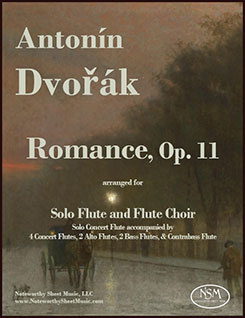 Romance, Op. 11 by Antonín Dvořák
Romance, Op. 11 by Antonín Dvořák
Arranged for Solo Flute and Flute Choir by C. A. Vater (originally for solo violin and orchestra)
Score and Parts for Solo Concert Flute, 4 Concert Flutes, 2 Alto Flutes, 2 Bass Flutes, and 1 Contrabass Flute, PDF $21.97
Czech composer Antonín Dvořák based his Romance, Opus 11 on the slow movement of his String Quartet in F minor, composed in 1873, re-working that Andante con moto quasi allegretto to create two versions of the Romance, one for solo violin and orchestra (B.39) and another for solo violin and piano (B.38). The Romance is one of Dvořák’s most magnificent melodic works, teaming with romance, lyricism, and emotional intensity. I created a solo flute version of this piece for my personal use, and I so enjoyed playing it that I shared it with a flutist friend / NSM editorial consultant, who suggested that the Romance might be nicely adaptable for flute choir. I took on that challenge and created this arrangement, scored for flute solo with the accompaniment of four concert flutes, two alto flutes, two bass flutes, and one contrabass flute. A few changes have been incorporated in the solo part, bringing the violin’s lowest notes into concert flute range and providing appropriate alternatives to the occasional double stops. Likewise, the various string and wind parts created by Dvořák for his orchestral arrangement (available on IMSLP.org) have been modified in places to suit members of the flute family. Of course, any work played by a flute choir will sound very different than when played by an orchestra, but in arranging this piece for flute choir, every effort has been made to maintain the spirit, character, balance, and flow of Dvořák’s exquisite Romance.
The parts in our edition have been formatted for convenient page turns when the complete PDF is printed 2-sided in its entirety. If a more compact version of the score is desired, however, please select a “2 pages per sheet” printer option for the score and print the score pages separately from the parts.
Score, 60 pages; Solo Flute part, 4 pages of music; Flutes 1-4 parts, each 3 pages of music; Alto Flute 1 part, 4 pages of music; Alto Flute 2 part, 3 pages of music; Contrabass Flute part, 3 pages of music; Total, 104 pages.
PreviewHaydn - Fugue from Op.20 No.2, arr. for Flute Quartet
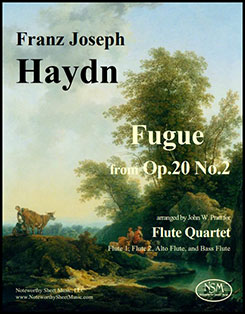 Fugue from Op.20 No.2, by Franz Joseph Haydn
Fugue from Op.20 No.2, by Franz Joseph Haydn
Arranged for Flute Quartet by John W. Pratt (originally for strings)
Score and Parts for Flute 1, Flute 2, Alto Flute, and Bass Flute, PDF $14.99
Haydn's development of the string quartet, of which he was the father no less than of the symphony, reached maturity with his "Sun" quartets Op.20. The finales of three of the Op.20 quartets are fugues, and are regarded as highly important because they set the standard for contrapuntal texture in quartets. They are as lively and fun as any other Haydn finale, and all four instruments share the action. Transposed up a fourth, the finale of Op.20 No.2 suits the range of a flute quartet with some adaptation, mostly for the bass flute. It is a blast to play. —JWP
Score, 12 pages; Flute 1 part, 3 pages; Flute 2 part, 3 pages; Alto Flute part, 3 page; Bass Flute part, 2 pages; Total,30 pages.
PreviewHaydn - Fugues from Op.20 No.5 and No.6, arr. for Flute Quartet
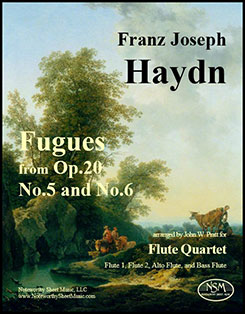 Fugues from Op.20 No.5 and No.6 by Franz Joseph Haydn
Fugues from Op.20 No.5 and No.6 by Franz Joseph Haydn
Arranged for Flute Quartet by John W. Pratt (originally for strings)
Scores and Parts for Flute 1, Flute 2, Alto Flute, and Bass Flute, PDF $21.75
Haydn’s quartets through Op.20 made him the father of the string quartet no less than of the symphony. Three of the finales of the Op.20 quartets are exuberant fugues with multiple subjects (Haydn “soggetti”) ... four subjects in No.2, two in No.5, and three in No.6. John Pratt has arranged these lively fugues for flute quartet; this edition includes two of the fugues, those from Op.20 No.5 and No.6, while the Op.20 No.2 fugue has been published separately. A group of four flutes is well suited to the kittens-on-the-keys feel of Haydn’s Op.20 fugues, and they are a blast to play. For the arrangements in this publication, the No.5 fugue has been transposed up a major third and the No.6 fugue up a minor third to bring them into better range for flutes.
Scores, 20 pages; Flute 1 parts, 4 pages; Flute 2 parts, 4 pages; Alto Flute parts, 4 pages; Bass Flute parts, 4 pages; Total,46 pages.
PreviewHaydn - Op.1, No.1- arr. Flute Quartet
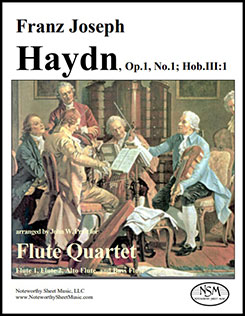 Quartet, Op.1, No.1, by Franz Joseph Haydn
Quartet, Op.1, No.1, by Franz Joseph Haydn
Arranged for Flute Quartet by John W. Pratt (originally for strings)
Score and Parts for Flute 1, Flute 2, Alto Flute, and Bass Flute, PDF $15.99
The earliest quartets of Franz Joseph Haydn are not precursors of the later works wherein he developed the form and style of the classical string quartet, but rather divertimenti written for four friends when he was about 25. Most of these early works have five movements: fast, minuet/trio, slow, minuet/trio, fast; and their slow movements feature beautiful, elaborate, gently accompanied melodies.
The divertimento style and instrumental character of these early pieces does not evoke strings specifically or necessarily, and thus arrangement for other instruments is natural and might expand enjoyment of these wonderful first significant Haydn works to other players and audiences. In John Pratt’s arrangement of Haydn’s Op.1, No.1 (Hob.III:1), most of the range issues for flutes were solved by transposition up a step, a few more by exchanging the two inner voices in places or by octave transpositions. This lovely, effective arrangement is for a flute quartet consisting of two concert flutes, alto flute, and bass flute; the edition is available exclusively from Noteworthy Sheet Music.
Score, 19 pages; Parts for Flute 1, Flute 2, Alto Flute and Bass Flute, 5 pages each; Total, 46 pages.
PreviewHaydn – Adagio from Symphony No.24 – trans. Solo Flute and Flute Choir
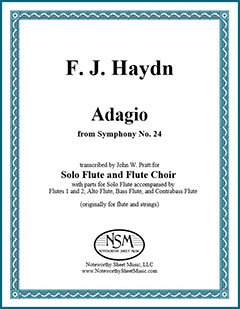 Adagio from Symphony No.24 by F. J. Haydn
Adagio from Symphony No.24 by F. J. Haydn
Transcribed for Solo Flute accompanied by Flute Choir, by John W. Pratt (originally for flute and strings)
Score and Parts for Solo Flute, Flutes 1 and 2, Alto Flute, and Bass Flute/Contrabass Flute, PDF $7.99
Haydn wrote his Symphony No.24 in 1764. Its second movement is a beautiful Adagio for flute solo accompanied by strings. The string parts are simple, with no double stops or extreme high notes, so they can be played comfortably by corresponding members of the flute family, except for a few low notes. This transcription for flute choir is therefore straightforward except that the alto flute sometimes plays violin notes that C-flutes cannot play or can use support playing, and similarly the bass flute plays some viola notes instead of or in addition to the alto flute playing them. Notes taken from the cello in its lowest octave have been raised an octave for bass flute, but there are fewer than one might expect. Perhaps one reason is that Haydn expected a (string) bass to be doubling the cello an octave lower, playing from the same part. If a contrabass flute is available, it can double the bass flute similarly, serving even more to enrich the sound. —adapted from JWP’s preface to the edition
Listen to a computer-generated audio sample.
Score, 5 pages; Parts for Solo Flute, 2 pages; Flutes 1 and 2, 2 pages; Alto Flute, 1 page; Bass Flute/Contrabass Flute, 1 page; Total 19 pages.
PreviewHaydn – Hob. II:21 – arr. Flute Quartet
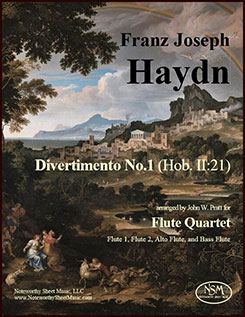 Divertimento No. 1 (Hob. II:21; Op. 2 No. 3) by Franz Joseph Haydn
Divertimento No. 1 (Hob. II:21; Op. 2 No. 3) by Franz Joseph Haydn
Arranged for Flute Quartet by John W. Pratt (originally for string quartet plus 2 horns)
Score and Parts for Flute 1, Flute 2, Alto Flute, and Bass Flute, PDF $11.97
excerpted from John W. Pratt’s © preface to the edition:
“Haydn (1732-1809) is credited with developing the classical forms of both the string quartet and the symphony, starting from the loose structures and permissive instrumentation of Baroque instrumental music. … His first string quartets are his Opus 1 Nos. 1-4 and 6, and Opus 2 Nos. 1-6, thus eleven. Opus 1 No. 5 is somewhat later, added to make a set of 6, apparently a perfect number in music publication as well as in mathematics. Opus 2 Nos. 3 and 5 are quartet arrangements of two divertimentos including also two horns and listed in the Hoboken catalogue as II:21 and 22 … The spirit and spiritedness of the two divertimentos suit them to flute quartet, as does the distribution of activity. In addition, a flute quartet combines the unified timbre of a string quartet with the wind sound of the horns, while the early string quartets do not exploit the string sound per se. Transposition up a step puts the cello and viola parts of Hob. II:21 mostly within the bass and alto flute ranges and makes the violin parts if anything more comfortable for C flutes.”
There are 5 movements in total: I-Allegro molto, II-Minuet, III-Adagio, IV-Minuet, and V-Finale Allegro. To get some sense of how the Op. 2 No. 3 quartet works with flutes in lieu of strings, listen to this computer-generated audio clip of the first movement—realizing it will of course sound considerably better played in-person on real instruments.
Score, 11 pages; Flute 1 part, 6 pages; Flute 2 part, 6 pages; Alto Flute part, 5 pages; Bass Flute part, 5 pages; Total, 38 pages.
PreviewHaydn – Hob. II:22 – arr. Flute Quartet
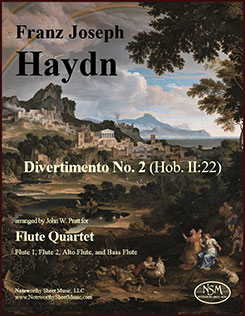 Divertimento No. 2 (Hob. II:22; Op.2, No.5) by Franz Joseph Haydn
Divertimento No. 2 (Hob. II:22; Op.2, No.5) by Franz Joseph Haydn
Arranged for Flute Quartet by John W. Pratt (originally for string quartet plus 2 horns)
Score and Parts for Flute 1, Flute 2, Alto Flute, and Bass Flute, PDF $10.97
This is the second of Haydn’s two divertimenti, Hob. II:21 and II:22, that John Pratt has arranged for flute quartet, scored for two C-flutes, alto flute, and bass flute. Both divertimenti were written originally for string quartet plus two horns, but were later adapted by others as quartet-only versions identified as Opus 2, No.3 and No.5. Please see the text excerpted from Mr. Pratt’s preface to his arrangement of Haydn’s Divertimento No.1 (Op.2, No.3) for additional information that applies to both these works. There are 5 movements in Op.2, No.5: I-Presto, II-Minuet, III-Largo, IV-Minuet, and V-Finale Presto. Listen to this computer-generated audio clip from the second movement Minuet to get a sense of how the quartet sounds with flutes in lieu of strings.
Score, 10 pages; Flute 1 part, 4 pages; Flute 2 part, 4 pages; Alto Flute part, 4 pages; Bass Flute part, 3 pages; Total, 28 pages.
PreviewHaydn – Symphony 13 - arr. for Multiple Flutes
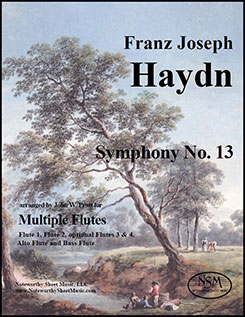 Symphony 13, by Franz Joseph Haydn
Symphony 13, by Franz Joseph Haydn
Arranged for Multiple Flutes by John W. Pratt
Score and Parts for Flutes 1-4, Alto Flute, Bass Flute; PDF $23.95
This arrangement of Haydn’s Symphony No.13 is for a flute ensemble of any size including at least one bass, one alto, and two concert flutes. Third and fourth concert flute parts are also provided, and all parts can be doubled at will. If a contrabass flute is available, it can double the bass flute, serving to deepen and enrich the sound. The second movement is a beautiful Adagio cantabile, originally for solo cello accompanied by strings, which transcribes nicely for alto flute accompanied by the rest of the flute family. The trio of the symphony’s third movement has a delightful solo flute part with only string accompaniment. A large flute ensemble would be about the size of Haydn’s core orchestra at the time this symphony was composed; in our arrangement, Haydn’s original key has been raised a minor third to better suit the natural range of a flute ensemble.
Score, 17 pages; separate parts for Flute 1, Flute 2, Flute 3, and Flute 4, 6 pages each; Alto Flute part, 7 pages; Bass Flute part, 6 pages; Total, 68 pages.
PreviewMozart - Quintet, K.515, arr. Flute Quintet
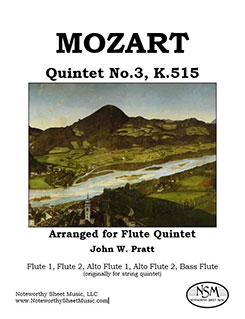 Quintet, K.515, by Wolfgang Amadeus Mozart
Quintet, K.515, by Wolfgang Amadeus Mozart
Arranged for Flute Quintet by John W. Pratt (originally for strings)
Score and Parts for Flute 1, Flute 2, Alto Flute 1, Alto Flute 2, and Bass Flute, PDF $26.50
Wolfgang Amadeus Mozart wrote six quintets for 2 violins, 2 violas, and cello. Two of these, K.515 in C major and K.516 in G minor, are generally regarded as high points in Mozart’s, and indeed all, chamber music. Performances of K.515 are infrequent, far less than such great music deserves, since there is not enough repertoire to support permanent string quintets and string quartets have an abundance of great music to play without needing to find an additional violist. Adaptation to flute quintet is thus particularly apropos, as its textural possibilities apply also to a flute quintet, and its musical and emotional content are well worth viewing through the prism of five flutes. Our edition includes a score as well as parts for two concert flutes, two alto flutes, and bass flute. (adapted from jwp’s foreword to the edition)
Score, 37 pages; Flute 1, 16 pages of music; Flute 2, 14 pages of music; Alto Flute 1, 16 pages of music; Alto Flute 2, 14 pages of music; and Bass Flute, 14 pages of music; Total, 124 pages.
Preview- 1
- 2
